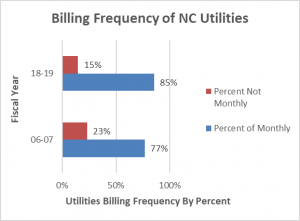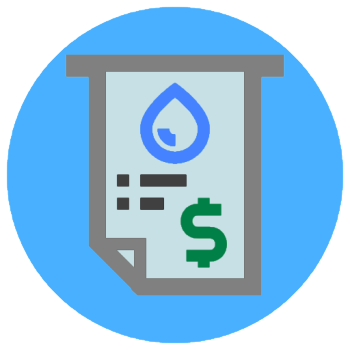Written by Stephen Lapp
At the Environmental Finance Center at UNC-Chapel Hill, we are always communicating that how you pay for it matters, but could how often you pay for it matter as well? It may seem counter-intuitive to think that receiving bills more regularly would be positive, but there are many reasons why utilities have trended towards monthly billing and away from bi-monthly, quarterly, semi-annually, or even annual billing. From FY2007 to FY2019, there has been an 8% increase in utilities that bill monthly in North Carolina, all of which switched from less frequent billing. Here are some reasons that water utilities are trending towards more frequent billing patterns:
Monthly billing allows customers to better manage their household budget and monitor their water usage.
Monthly billing helps customers establish a payment rhythm. Customers can estimate their monthly payment and build that amount into their budget versus having a larger expense come up a few times throughout the year. While a monthly bill of $50, a quarterly bill of $150, or a semiannual bill of $300 will all generate the same revenues for a utility, $50 is more affordable for a customer to pay at a given time. Many customers operate on a month by month basis when it comes to expenses, as most bills (think: cell phone, electricity, credit card, rent, etc.) come once a month, every month. As such, customers may not have the foresight to save a little each month for a larger quarterly or semiannual expense.

The EFC has conducted rates surveys in different states, which have provided information for the Rates Dashboards. These resources can be used to analyze water rates, wastewater rates, and utility finances.
Monthly billing allows for increased communication between the utility and customer.
For most communities, the only communication between a utility and its customers comes in the form of the utility bill. As such, more frequent billing cycles allow for more regular communication and fewer surprises. This increased monitoring and reporting equips utilities and customers with the information to notice leaks sooner. Early leak detection benefits customers financially, so they are not paying for water they aren’t using and can more quickly discover leaks that could result in expensive damage to their home. Usage from these kinds of leaks can add up quickly and are a significant addition to a bill, especially if this accumulation occurs over several months.
From the utility perspective, there are also benefits to this increased communication. For example, if a utility is trying to conserve water or is concerned about supply and a customer has a leak, it is beneficial for the utility to help the customer recognize that issue earlier rather than later. The customer has a financial incentive to address the issue quickly , allowing the utility to quickly recapture the lost supply from the leak. Similarly, monthly billing allows utilities to recognize meter issues, such as broken or slow meters. This provides the utility the opportunity to address this lost revenue more quickly and regain the revenue stream.
Monthly billing increases utility financial security.
In the absence of monthly billing, greater time between billing cycles may mean that it is necessary for the utility to have an increased amount of days of cash on hand to ensure financial security. A general rule of thumb is that, at minimum, a utility should have enough cash on hand to get them through their billing period. Water and wastewater systems are enterprise funds, meaning that the revenue from rates should cover the cost of operation. However, when a utility bills less frequently, there is less regularity to when they are receiving revenue, provided that all their customers are on the same schedule. Having adequate days of cash on hand can become trickier if there are unexpected expenses or revenue shortfalls that come between longer billing periods. Unless a utility has a greater amount of cash on hand, they may run into issues if unforeseen expenses or revenue shocks occur.
In short, there are several advantages to billing more frequently. Nevertheless, many utilities still choose to bill bi-monthly, quarterly, or semi-annually. While billing more frequently provides utilities with a more stable revenue stream, can help recognize issues with metering and detecting customer leaks, and may assist with customer-level budgeting, it comes at an added expense. Reading meters more frequently and distributing more frequent bills add administrative and personnel costs to the utility, which in some cases may not outweigh the financial benefits. Every utility should assess their customer base and their finances when considering billing frequency but should keep in mind the potential financial benefits and revenue stability of more regular billing.
Want more information on utility finance and management? Check out our helpful Tools to Assist Water Utilities with Financial Decision-Making
Stephen Lapp joined the EFC at UNC in 2018. In his role as Project Manager, he conducts applied research and provides technical assistance and training for environmental service providers. Lapp holds a BA in Environmental Studies with a minor in Urban Studies and Planning from the University of North Carolina.





Leave a Reply